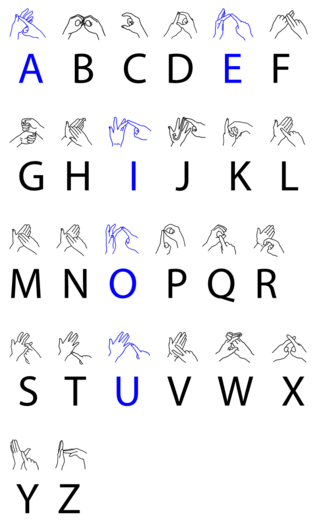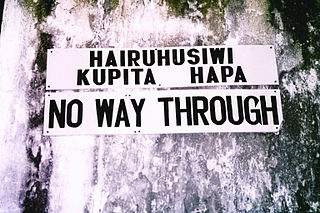Related Research Articles

American Sign Language (ASL) is a natural language that serves as the predominant sign language of Deaf communities in the United States and most of Anglophone Canada. ASL is a complete and organized visual language that is expressed by employing both manual and nonmanual features. Besides North America, dialects of ASL and ASL-based creoles are used in many countries around the world, including much of West Africa and parts of Southeast Asia. ASL is also widely learned as a second language, serving as a lingua franca. ASL is most closely related to French Sign Language (LSF). It has been proposed that ASL is a creole language of LSF, although ASL shows features atypical of creole languages, such as agglutinative morphology.

Sign languages are languages that use the visual-manual modality to convey meaning, instead of spoken words. Sign languages are expressed through manual articulation in combination with non-manual markers. Sign languages are full-fledged natural languages with their own grammar and lexicon. Sign languages are not universal and are usually not mutually intelligible, although there are also similarities among different sign languages.

International Sign (IS) is a pidgin sign language which is used in a variety of different contexts, particularly as an international auxiliary language at meetings such as the World Federation of the Deaf (WFD) congress, in some European Union settings, and at some UN conferences, at events such as the Deaflympics, the Miss & Mister Deaf World, and Eurovision, and informally when travelling and socialising.

British Sign Language (BSL) is a sign language used in the United Kingdom and is the first or preferred language among the deaf community in the UK. While private correspondence from William Stokoe hinted at a formal name for the language in 1960, the first usage of the term "British Sign Language" in an academic publication was likely by Aaron Cicourel. Based on the percentage of people who reported 'using British Sign Language at home' on the 2011 Scottish Census, the British Deaf Association estimates there are 151,000 BSL users in the UK, of whom 87,000 are Deaf. By contrast, in the 2011 England and Wales Census 15,000 people living in England and Wales reported themselves using BSL as their main language. People who are not deaf may also use BSL, as hearing relatives of deaf people, sign language interpreters or as a result of other contact with the British Deaf community. The language makes use of space and involves movement of the hands, body, face and head.
A lingua franca, also known as a bridge language, common language, trade language, auxiliary language, vehicular language, or link language, is a language systematically used to make communication possible between groups of people who do not share a native language or dialect, particularly when it is a third language that is distinct from both of the speakers' native languages.
Auslan is the sign language used by the majority of the Australian Deaf community. The term Auslan is a portmanteau of "Australian Sign Language", coined by Trevor Johnston in the 1980s, although the language itself is much older. Auslan is related to British Sign Language (BSL) and New Zealand Sign Language (NZSL); the three have descended from the same parent language, and together comprise the BANZSL language family. Auslan has also been influenced by Irish Sign Language (ISL) and more recently has borrowed signs from American Sign Language (ASL).

New Zealand Sign Language or NZSL is the main language of the deaf community in New Zealand. It became an official language of New Zealand in April 2006 under the New Zealand Sign Language Act 2006. The purpose of the act was to create rights and obligations in the use of NZSL throughout the legal system and to ensure that the Deaf community had the same access to government information and services as everybody else. According to the 2013 Census, over 20,000 New Zealanders know NZSL.
Manually Coded English (MCE) is a type of sign system that follows direct spoken English. The different codes of MCE vary in the levels of directness in following spoken English grammar. There may also be a combination with other visual clues, such as body language. MCE is typically used in conjunction with direct spoken English.
Old French Sign Language was the language of the deaf community in 18th-century Paris at the time of the establishment of the first deaf schools. The earliest records of the language are in the work of the Abbé de l'Épée, who stumbled across two sisters communicating in signs and, through them, became aware of a signing community of 200 deaf Parisians.

Tabora is the capital of Tanzania's Tabora Region and is classified as a municipality by the Tanzanian government. It is also the administrative seat of Tabora Urban District. According to the 2012 census, the district had a population of 226,999.
Indo-Pakistani Sign Language (IPSL) is the predominant sign language in the subcontinent of South Asia, used by at least 15 million deaf signers. As with many sign languages, it is difficult to estimate numbers with any certainty, as the Census of India does not list sign languages and most studies have focused on the north and urban areas. As of 2021, it is the most used sign language in the world, and Ethnologue ranks it as the 151st most "spoken" language in the world.

Tabora Region is one of Tanzania's 31 administrative regions. The regional capital is the municipality of Tabora. The region is located in mid-western part of Tanzania. Tabora is bordered by Shinyanga to the north, Singida to the east, Mbeya and Songwe to the south. lastly, Katavi, Kigoma and Geita, border Tabora to the west. Tabora is by far the largest region in Tanzania by area. Most of the population in the region is concentrated in the north in Nzega district. According to the 2012 national census, Tabora Region had a population of 2,291,623.
Kenyan Sign Language is a sign language used by the deaf community in Kenya and Somalia. It is used by over half of Kenya's estimated 600,000 deaf population. There are some dialect differences between Kisumu, Mombasa and Somalia.
Italian Sign Language or LIS is the visual language used by deaf people in Italy. Deep analysis of it began in the 1980s, along the lines of William Stokoe's research on American Sign Language in the 1960s. Until the beginning of the 21st century, most studies of Italian Sign Language dealt with its phonology and vocabulary. According to the European Union for the Deaf, the majority of the 60,000–90,000 Deaf people in Italy use LIS.
Korean Sign Language or KSL is a sign language used for deaf communities of South Korea. It is one of two official languages in the country, alongside Korean.
Greek Sign Language (ENG) is a sign language used by the Greek deaf community.
Nyakyusa, or Nyakyusa-Ngonde, is a Bantu language of Tanzania and Malawi spoken by the Nyakyusa people around the northern end of Lake Malawi. There is no single name for the language as a whole; its dialects are Nyakyusa, Ngonde (Konde), Kukwe, Mwamba (Lungulu), and Selya of Tanzania. Disregarding the Bantu language prefixes Iki- and Ki-, the language is also known as Konde ~ Nkhonde, Mombe, Nyekyosa ~ Nyikyusa, and Sochile ~ Sokili.
Nepalese Sign Language or Nepali Sign Language is the main sign language of Nepal. It is a partially standardized language based informally on the variety used in Kathmandu, with some input from varieties from Pokhara and elsewhere. As an indigenous sign language, it is not related to oral Nepali. The Nepali Constitution of 2015 specifically mentions the right to have education in Sign Language for the deaf. Likewise, the newly passed Disability Rights Act of 2072 BS defined language to include "spoken and sign languages and other forms of speechless language." in practice it is recognized by the Ministry of Education and the Ministry of Women, Children and Social Welfare, and is used in all schools for the deaf. In addition, there is legislation underway in Nepal which, in line with the UN Convention on the Rights of Persons with Disabilities (UNCRPD) which Nepal has ratified, should give Nepalese Sign Language equal status with the oral languages of the country.

Tanzania is a multilingual country. There are many languages spoken in the country, none of which is spoken natively by a majority or a large plurality of the population. Swahili and English, the latter of which was inherited from colonial rule, are widely spoken as lingua francas. They serve as working languages in the country, with Swahili being the official national language. There are more speakers of Swahili than of English in Tanzania.

Black American Sign Language (BASL) or Black Sign Variation (BSV) is a dialect of American Sign Language (ASL) used most commonly by deaf African Americans in the United States. The divergence from ASL was influenced largely by the segregation of schools in the American South. Like other schools at the time, schools for the deaf were segregated based upon race, creating two language communities among deaf signers: black deaf signers at black schools and white deaf signers at white schools. As of the mid 2010s, BASL is still used by signers in the South despite public schools having been legally desegregated since 1954.
References
- 1 2 Tanzanian Sign Language at Ethnologue (18th ed., 2015) (subscription required)
- ↑ Muzale, MRT (2004). Kamusi ya Lugha ya Alama ya Tanzania (LAT) / Tanzanian Sign Language (TSL) Dictionary. ISBN 9987-691-02-1.
- ↑ "Documentation and description of the Tabora variety of Tanzanian Sign Language". Projects. Universiteit Leiden. Retrieved 25 October 2019.